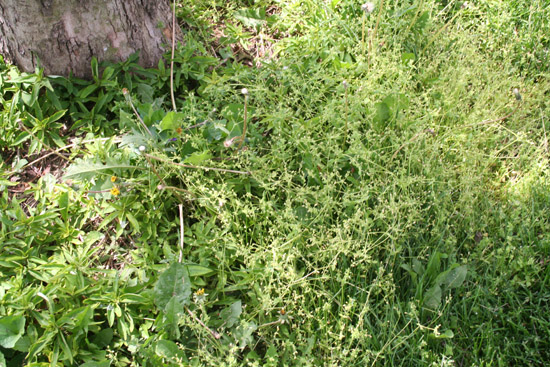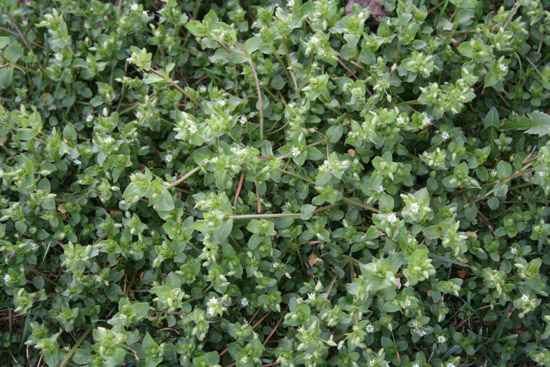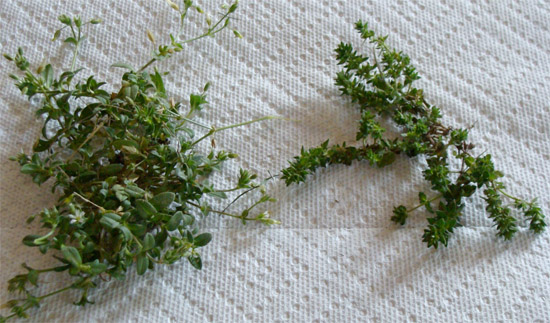Issue 3, May 7, 2012
Chickweed is Struttin' Its Stuff
Has this weed ruffled your feathers? Before you think I've flown the coop, I'll stop with the chick humor.
There is certainly no shortage of chickweed in Illinois this spring. The mild winter and warm conditions early on have likely led to the increased populations we are seeing. Common chickweed (Stellaria media) is a cool-season annual (also known as a winter annual) member of the Pink family (Caryophyllaceae) that reproduces by seeds. Normally, cool-season annuals germinate in the autumn, flower the following spring, and die soon after summer temperatures rise; common chickweed, however, may occasionally persist through summer in sites protected from heat and drought. Common chickweed occurs in cool, moist, shady, often compacted, fertile sites in spring and autumn.

Chickweed stems sprawling over turf and low growing plants
Common chickweed often forms large, dense patches in mowed areas but grows more upright in unmowed settings. The stems will often form mats over surrounding low growing plants. The stems are softly hairy. The roots are shallow and fibrous. Leaves are bright green, opposite, simple, broadly oval, and usually less than 1 inch long. Its small, spring-borne white flowers are approximately 1/2 inch in diameter, have five petals, and are star shaped. The 5 petals are deeply lobed and appear from a distance as 10 petals.

Chickweed in flower
To control common chickweed without chemicals, maintain turf density and health by employing proper turf culture and mechanically remove the weed from the site. For chemical control, apply postemergence herbicides (for example, products containing 2,4-D; MCPP; dicamba, clopyralid, or triclopyr) in midspring or mid- to late autumn during active growth; apply preemergence herbicides (for example, products containing benefin + trifluralin, dithiopyr, pendimethalin, or prodiamine) before germination in late summer or early autumn. Because most common chickweed plants are currently senescing and will soon die, application of chemical weed controls is not recommended any longer this spring. This plant pulls easily.
A closely related plant is mouseear chickweed (Cerastium vulagtum). This weed has a similar growth habit, however it is a perennial which commonly roots at the nodes. The leaves are densely hairy and typically quite oblong. It occurs less commonly in a general turfgrass or landscape setting.
The speedwells (Veronica sp.) also are noticeable this time of year and have a similar growth habit, leaf shape, and color. Speedwell leaves are more closely arranged on the stem and the flowers are pale blue to white. There are several species of speedwell.

Mouseear chickweed on the left; Speedwell on the right.
(Michelle Wiesbrook, adapted from an HYG article by Tom Voigt, Bruce Spangenberg, and Luke Cella)
Author:
Michelle Wiesbrook